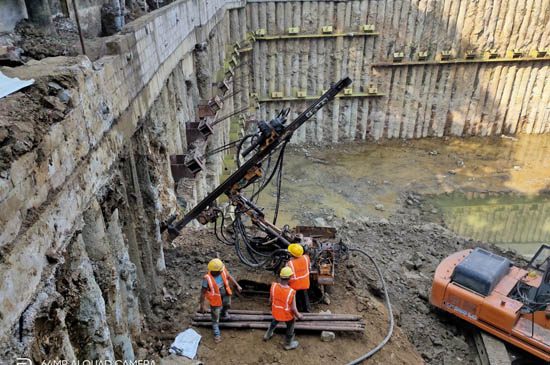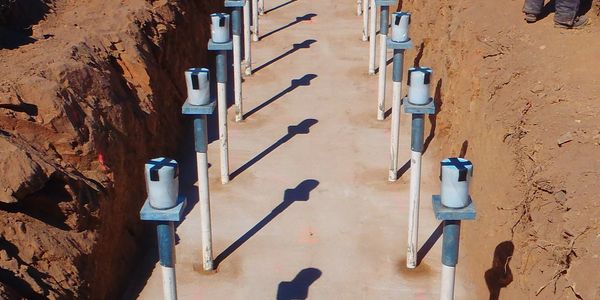Just How Williams Anchors Offer Stability for Large-Scale Framework Projects
Just How Williams Anchors Offer Stability for Large-Scale Framework Projects
Blog Article
Reliable Rock Anchors for Secure and Steady Foundations
In the world of civil design, the duty of dependable rock supports can not be overemphasized, as they are crucial in developing safe and secure and secure structures across a variety of applications. Understanding the different kinds of rock supports, their certain applications, and the complexities of installment and maintenance is vital for optimizing their efficiency.
Sorts Of Rock Anchors

Easy anchors rely on the weight of the framework and the surrounding dirt or rock to supply resistance. They are normally used in applications where minimal motion is expected. Energetic anchors, on the various other hand, entail the application of stress through a high-strength cord or pole, creating a pre-stressed condition in the anchor. This type is specifically beneficial in vibrant settings, such as landslide-prone locations.
Grouted anchors are another considerable group, in which a steel bar or cord is inserted into a pierced opening, followed by a cementitious grout. Once treated, the grout bonds with the bordering rock, developing a durable anchoring system. Each kind of rock anchor offers distinctive advantages based on the particular geological conditions and architectural demands, therefore playing an essential function in the general stability and durability of built centers.
Applications in Building And Construction
Rock anchors play a pivotal duty in numerous building applications, supplying vital support and security in varied atmospheres. These innovative solutions are made use of in jobs ranging from large-scale framework advancements to smaller residential frameworks. One of the primary applications of rock supports is in the stabilization of inclines and keeping wall surfaces, where they assist avoid dirt disintegration and maintain architectural stability.
In addition, rock anchors are important in safeguarding foundations for bridges, passages, and high-rise structures, ensuring they can withstand lateral pressures such as wind and seismic activity. Their convenience enables installation in difficult geological problems, making them suitable for projects in mountainous or rough terrains.

Key Choice Standards
Selecting the proper rock support for a particular application calls for careful consideration of numerous vital criteria. The geological problems of the website have to be completely assessed. Recognizing rock type, strength, and security is vital to ensure that the anchor will perform properly under tons conditions.

An additional vital variable is the deterioration resistance of the support products. In settings revealed to dampness or chemicals, making use of corrosion-resistant products will certainly extend the life expectancy of the anchors and maintain structural integrity over time.
Additionally, the support's installment technique must line up with the project's requirements and restraints. Reduce of installment, in addition to the prospective effect on surrounding frameworks, need to be thought about.
Installation Techniques
Reliable setup techniques are crucial for the effective her response efficiency of rock anchors. Correct setup guarantees that the supports accomplish the desired load-bearing ability and stability within the geological conditions. The primary step in the installment procedure involves website assessment, where geological studies figure out the rock type, problem, and any possible challenges.
As soon as the site is reviewed, the suitable drilling technique must be chosen-- options include rotating boring, diamond boring, or percussion exploration. The option depends on rock firmness and ecological considerations. Exact drilling deepness and angle are important to ensure that the anchors straighten with structural requirements and lots distribution.
After exploration, the next stage involves cleaning up the borehole to get rid of particles, which can compromise bond stamina. Following this, the support is inserted, and if needed, a cement or resin is infused to boost adhesion. The curing time of these products have to be complied with, making certain that the anchors achieve complete toughness before any type of lots is applied.
Maintenance and Examination
Correct upkeep and examination of rock anchors are vital to guarantee their lasting performance and integrity (Williams Anchors). Routine assessments aid recognize any kind of potential issues, such as corrosion, displacement, or structural fatigue that could compromise the integrity of the anchoring system
Routine inspections should be conducted at specified periods, thinking about ecological variables and the details application of the rock supports. Aesthetic assessments must concentrate on the exposed sections of the supports, looking for indications of rust, cracks, or various other abnormalities. Furthermore, it is important to assess the surrounding geological conditions to identify any kind of shifts in soil or rock that might impact anchor efficiency.
Sometimes, even more advanced strategies such as tons testing or non-destructive screening may be warranted to identify the supports' load-bearing capacity and total health and wellness. Proper documents of assessment findings, upkeep activities, and any kind of repair services or replacements executed is important for recurring examination and compliance with market standards.
Final Thought
Finally, trusted rock anchors play a critical function in ensuring safe and stable foundations throughout various building and construction applications. By effectively moving lots and enhancing security versus lateral forces, these supports add considerably to the long life and integrity of structures such as bridges, passages, and preserving walls. Strategic choice, installment, and upkeep of rock anchors are vital for maximizing efficiency and protecting public security, inevitably emphasizing their significance in contemporary design techniques.
Report this page